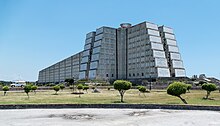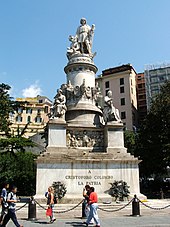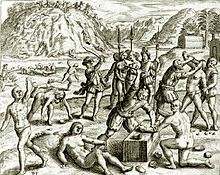| Columbus Day | |
|---|---|

First Landing of Columbus on the Shores of the New World; painting by Dióscoro Puebla (1862)
| |
| Observed by | Various countries in the Americas, Italy, Spain, various Little Italys around the world. |
| Type | Historical |
| Significance |
|
| Date | October 12 (actual/traditional); second Monday in October (observed in the United States) |
| 2019 date | October 14 |
| 2020 date | October 12 |
| 2021 date | October 11 |
| 2022 date | October 10 |
| Frequency | Annual |
Columbus Day is a national holiday in many countries of the Americas and elsewhere which officially celebrates the anniversary of Christopher Columbus's arrival in the Americas on October 12, 1492 (Julian Calendar; it would have been October 21, 1492 on the Gregorian Proleptic Calendar, which extends the Gregorian Calendar to dates prior to its adoption in 1582). Christopher Columbus was an Italian explorer and colonizer who set sail across the Atlantic Ocean in search of a faster route to the Far East only to land at the New World. His first voyage to the New World on the Spanish ships Santa María, Niña, and La Pinta took approximately three months. Columbus and his crew's arrival to the New World initiated the Columbian Exchange which introduced the transfer of plants, animals, culture, human populations, and technology (but also invasive species, including communicable diseases) between the New World and the Old World.
The landing is celebrated as Columbus Day in the United States but the name varies on the international spectrum. In some Latin American countries, October 12 is known as Día de la Raza or (Day of the Race). This is the case for Mexico, which inspired Jose Vasconcelos's book celebrating the Day of the Iberoamerican Race. Some countries such as Spain refer the holiday as Día de la Hispanidad and Fiesta Nacional de España where it is also the religious festivity of la Virgen del Pilar. Since 2009, Peru has celebrated Día de los pueblos originarios y el diálogo intercultural (Indigenous Peoples and Intercultural Dialogue Day). Belize and Uruguay celebrate it as Día de las Américas (Day of the Americas). Giornata Nazionale di Cristoforo Colombo or Festa Nazionale di Cristoforo Colombo is the formal name of Italy's celebration as well as in Little Italys around the world.
United States observance
History
Stylized graphic from the United States Department of Defense
Celebration of Christopher Columbus' voyage in the early United States is recorded from as early as 1792. In that year, the Tammany Society in New York City (for whom it became an annual tradition) and the Massachusetts Historical Society in Boston celebrated the 300th anniversary of Columbus' landing in the New World.
For the 400th anniversary in 1892, following a lynching in New Orleans where a mob had murdered 11 Italian immigrants, President Benjamin Harrison declared Columbus Day as a one-time national celebration.
The proclamation was part of a wider effort after the lynching incident
to placate Italian Americans and ease diplomatic tensions with Italy.
During the anniversary in 1892, teachers, preachers, poets and
politicians used rituals to teach ideals of patriotism. These rituals
took themes such as citizenship boundaries, the importance of loyalty to
the nation, and the celebration of social progress.
Many Italian-Americans
observe Columbus Day as a celebration of their heritage, and the first
such celebration had already been held in New York City on October 12,
1866.
The day was first enshrined as a legal holiday in the United States
through the lobbying of Angelo Noce, a first generation Italian, in
Denver.
The first statewide holiday was proclaimed by Colorado governor Jesse
F. McDonald in 1905, and it was made a statutory holiday in 1907.
In 1934, as a result of lobbying by the Knights of Columbus and New York City Italian leader Generoso Pope,
Congress passed a statute stating: “The President is requested to issue
each year a proclamation (1) designating October 12 as Columbus Day;
(2) calling on United States Government officials to display the flag of
the United States on all Government buildings on Columbus Day; and (3)
inviting the people of the United States to observe Columbus Day, in
schools and churches, or other suitable places, with appropriate
ceremonies that express the public sentiment befitting the anniversary
of the discovery of America.” President Franklin Delano Roosevelt
responded by making such a proclamation. This proclamation did not lead
to the federal holiday we have today. It was similar to language
regarding Thomas Jefferson's Birthday and Gold Star Mothers Day.
In 1966, Mariano A. Lucca, from Buffalo, NY, founded the National Columbus Day Committee, which lobbied to make Columbus Day a federal holiday. These efforts were successful and Columbus Day became a federal holiday in 1968.
Since 1971 (Oct. 11), the holiday has been attributed to the second Monday in October, coincidentally exactly the same day as Thanksgiving in neighboring Canada since 1957. It is generally observed nowadays by banks, the bond market, the U.S. Postal Service,
other federal agencies, most state government offices, many businesses,
and most school districts. Some businesses and some stock exchanges
remain open, and some states and municipalities abstain from observing
the holiday. The traditional date of the holiday also adjoins the anniversary of the United States Navy (founded October 13, 1775), and thus both occasions are customarily observed by the Navy and the Marine Corps with either a 72- or 96-hour liberty period.
Local observance of Columbus Day
Columbus Day in Salem, Massachusetts in 1892
Actual observance varies in different parts of the United States,
ranging from large-scale parades and events to complete non-observance.
Most states do not celebrate Columbus Day as an official state holiday.
Some mark it as a "Day of Observance" or "Recognition.” Most states
that celebrate Columbus Day will close state services, while others
operate as normal.
San Francisco claims the nation's oldest continuously existing
celebration with the Italian-American community's annual Columbus Day
Parade, which was established by Nicola Larco in 1868, while New York City boasts the largest, with over 35,000 marchers and one million viewers around 2010.
As in the mainland United States, Columbus Day is a legal holiday in the U.S. territory of Puerto Rico. In the United States Virgin Islands, the day is celebrated as both Columbus Day and "Puerto Rico Friendship Day."
Virginia also celebrates two legal holidays on the day, Columbus Day and Yorktown Victory Day, which honors the final victory at the Siege of Yorktown in the Revolutionary War.
Non-observance
The
celebration of Columbus Day in the United States began to decline at
the end of the 20th century, although many Italian-Americans and others,
continue to champion it. The states of Florida, Hawaii, Alaska, Vermont, South Dakota, New Mexico, Maine, Wisconsin, and parts of California including, for example, Los Angeles County do not recognize it and have each replaced it with celebrations of Indigenous People's Day (in Hawaii, "Discoverers' Day", in South Dakota, "Native American Day").
A lack of recognition or a reduced level of observance for Columbus
Day is not always due to concerns about honoring Native Americans. For
example, a community of predominantly Scandinavian descent may observe Leif Erikson Day instead. In the states of Oregon and Washington, Columbus Day is not an official holiday.
Iowa and Nevada
do not celebrate Columbus Day as an official holiday, but the states'
respective governors are "authorized and requested" by statute to
proclaim the day each year.
Several states have removed the day as a paid holiday for state
government workers, while still maintaining it—either as a day of
recognition, or as a legal holiday for other purposes, including California and Texas.
The practice of U.S. cities eschewing Columbus Day to celebrate Indigenous Peoples' Day began in 1992 with Berkeley, California. The list of cities which have followed suit as of 2018 includes Austin, Boise, Cincinnati, Denver, Los Angeles, Mankato, Minnesota, Portland, Oregon, San Francisco, Santa Fe, New Mexico, Seattle, St. Paul, Minnesota, Phoenix, Tacoma, and dozens of others. Columbus, Ohio has chosen to honor veterans instead of Christopher Columbus, and removed Columbus Day as a city holiday. Various tribal governments in Oklahoma designate the day as Native American Day, or name it after their own tribe.
Latin American observance
Día de la Raza
Argentine government poster from 1947 including the concept of la Raza.
The date Columbus arrived in the Americas is celebrated in some
countries of Latin America. The most common name for the celebration in
Spanish (including some Latin American communities in the United States) is the Día de la Raza ("day of the race" or the "day of the [Hispanic] people"), commemorating the first encounters of Europeans and the Native Americans. The day was first celebrated in Argentina in 1917, in Venezuela and Colombia in 1921, in Chile in 1922 and in Mexico it was first celebrated in 1928. The day was also celebrated under this title in Spain until 1957, when it was changed to the Día de la Hispanidad ("Hispanicity Day"), and in Venezuela it was celebrated under this title until 2002, when it was changed to the Día de la Resistencia Indígena
(Day of Indigenous Resistance). Originally conceived of as a
celebration of Hispanic influence in the Americas, as evidenced by the
complementary celebrations in Spain and Latin America, Día de la Raza
has come to be seen by nationalist activists throughout Latin America as
a counter to Columbus Day; a celebration of the native races and
cultures and their resistance to the arrival of Europeans in the
Americas.
In the United States, Día de la Raza has served as a time of mobilization for pan-ethnic Latino
activists, particularly since the 1960s. Since then, La Raza has served
as a periodic rallying cry for Hispanic activists. The first Hispanic
March on Washington occurred on Columbus Day in 1996. The name is still
used by the largest Hispanic social justice organization in the nation,
the National Council of La Raza.
Argentina
The Day of the Race was established in Argentina in 1916 by a decree of President Hipólito Yrigoyen. The name was changed to "Day of Respect of Cultural Diversity" by a presidential decree in 2010 issued by President Cristina Kirchner. Fittingly, the statue of the leader of the indigenous massacre, Columbus, was removed from its original position near the Casa Rosada and replaced by one of Juana Azurduy, a patriot and leader in the struggle for independence who had indigenous ancestors.
Colombia
Colombia, the only country in the world with a name originated from Columbus himself, celebrates El día de la Raza y de la Hispanidad (meaning "Day of the Race and Hispanicity")
and is taken as an opportunity to celebrate the encounter of "the two
worlds" and to reflect on the richness that the racial diversity has
brought to the culture.
Peru
In Peru, it was known as Día del descubrimiento de América ("Day of the discovery of America"). Since 2009, it has been celebrated as Día de los pueblos originarios y el diálogo intercultural (Indigenous Peoples and Intercultural Dialogue Day).
Venezuela
Statueless plinth in Caracas in 2006. A statue of Christopher Columbus by the 19th-century sculptor Rafael de la Cova,
which formerly occupied the plinth, was knocked down by activists after
a "public trial" during the celebrations of the newly instituted "Day
of the Indigenous Resistance" (October 12) in 2004.
Between 1921 and 2002, Venezuela celebrated Día de la Raza along with many other Latin American nations. The original holiday was officially established in 1921 under President Juan Vicente Gómez. In 2002, under President Hugo Chávez, the holiday was changed to Día de la Resistencia Indígena (Day of Indigenous Resistance) to commemorate the Indigenous peoples' resistance to European settlement.
On October 12, 2004, a crowd of pro-government activists toppled a statue of Christopher Columbus by Rafael de la Cova in Caracas. The activists also sprayed allusive graffiti
over its pedestal. The Walk where the statue had stood was renamed in
2008 "Indigenous Resistance Walk". Later a statue of an indigenous
leader, Guaicaipuro, was erected on the plinth.
Costa Rica
On September 21, 1994, Costa Rica changed the official holiday from Día de la Raza to Día del Encuentro de las Culturas (Day of the Encounter of Cultures) to recognize the mix of European, Native American (autochthonous populations), African and Asian cultures that constitute modern Costa Rican (and Latin American)
culture and ethnicity. In accordance to the Costa Rican labor law, the
holiday is observed on October 12. However, should this date coincide
with a Tuesday, Wednesday, Thursday or Friday, the employer shall agree
that said holiday be postponed to the following Monday.
Caribbean observance
Only a handful of Caribbean countries still observe holidays related to Columbus Day. In Belize, October 12 is celebrated as Day of the Americas or Pan American Day. In the Bahamas, it was formerly known as Discovery Day, until 2001 when it was replaced by National Heroes Day. In 1937, Cuban President Federico Laredo Brú
(1936–1940) spoke to the nation and countries of America in Cuba on
October 12 commemorating Christopher Columbus's voyage to the New World.
Federico Laredo Brú spoke about Columbus' impact on the land and the
future of its settlement. He ended his speech with venerating
Christopher Columbus' efforts to colonize and establish settlements
along the new front and the pride of ones nation. He added "Por mi raza
hablo mi espiritu," which translates to "For my race my spirit called,"
in order to support the political infrastructure at the time.
Columbus' Legacy in the Caribbean
The Columbus Lighthouse in Santo Domingo Este, Dominican Republic
December 1937, Cuban president Federico Laredo Brú and Dominican Republic president Rafael Trujillo
ordered a crew of aviators to travel through Latin America collecting
funds from large capital cities for a monumental light house in the
Dominican Republic. The exploration Escuadrilla Binacional Pro Faro de Colón
was inspired by Columbus' odyssey to the Americas where three of the
four planes were named after the vessels that journeyed across the North Atlantic Ocean (Santa María, Niña, and La Pinta). The expedition consisted of three Stinson Reliant SR-9 borrowed from the Cuban Air Force and a Curtiss Wright CW-19R from the Dominican military aviation named "Colombo" after Columbus. On December 15, after visiting a majority of South America, their destination in Lima, Peru was prolonagted due to an unexpected sandstorm locally knows as Paracas. Pilots of the Colon and La Pinta were forced to land in the city of Pisco
however La Nina disappeared in the storm. The Santa Maria was the only
plane to reach the Peruvian Capital as planned, landing at Las Palmas
on the day of the storm. After extensive searching rescue La Nina
radioed from Lima announcing their whereabouts after their radio was
damaged in the storm. The aircraft restrategized in Las Palmas and on
December 29 their expedition took off from El Techo airport in Bogotá en route to El Guabito airport in Cali.
Later that day the crew flew into an unexpected storm with minimal
visibility and poor navigation flying over the Valley of Cauca. La Nina, La Pinta and the Santa Maria flew straight into high mountains crashing to their deaths. Colon, unaware of the other aircraft flew over the storm and safely made it to Panama City. The CW-19R Colon is still preserved today as remembrance of the bravery of the crew and Christopher Columbus' odyssey. The Columbus Lighthouse stands today in the Dominican Republic.
European observance
Italy
Monument to Christopher Columbus in Genoa, Italy
Since the 18th century, many Italian communities in the Americas have observed the Discovery of the New World as a celebration of their heritage; Christopher Columbus (whose original, Italian name is "Cristoforo Colombo") was an Italian explorer, citizen of the Republic of Genoa.
In Italy, Columbus Day has been officially celebrated since 2004. It is officially named Giornata nazionale di Cristoforo Colombo.
The "Lega Navale Italiana" has created a Regata di Colombo as a celebration of the Columbus achievement. Italians have celebrated their "Cristoforo Colombo" naming after him many civilian and military ships, like the ocean liner SS Cristoforo Colombo.
Spain
Since 1987, Spain has celebrated the anniversary of Columbus's arrival in the Americas as its Fiesta Nacional or "National Day". Previously Spain had celebrated the day as Día de la Hispanidad, emphasizing Spain's ties with Hispanidad, the international Hispanic community. In 1981 a royal decree established the Día de la Hispanidad as a national holiday. However, in 1987 the name was changed to Fiesta Nacional, and October 12 became one of two national celebrations, along with Constitution Day on December 6.
Spain's "national day" had moved around several times during the
various regime changes of the 20th century; establishing it on the day
of the international Columbus celebration was part of a compromise
between conservatives, who wanted to emphasize the status of the
monarchy and Spain's history, and Republicans, who wanted to commemorate
Spain's burgeoning democracy with an official holiday. Since 2000, October 12 has also been Spain's Day of the Armed Forces, celebrated each year with a military parade in Madrid.
Other than this, however, the holiday is not widely or enthusiastically
celebrated in Spain. There are no large-scale patriotic parades,
marches or other events, but shops and businesses are closed as with
other bank holidays. The observation is generally overshadowed by the feast day of Our Lady of the Pillar (Fiestas del Pilar). This holiday was declared a religious feast day throughout the Spanish Empire in 1730. In recent years, celebration of the holiday has faced some opposition from various organizations.
Opposition to Columbus celebrations
Engraving by Theodor de Bry depicting the controversial account by Bartolomé de las Casas regarding the Brevísima relación de la destrucción de las Indias, 1552. De Bry's works are characteristic of the anti-Spanish propaganda that originated as a result of the Eighty Years' War, known as the Black Legend.
Opposition to Columbus Day dates back to at least the 19th century, when anti-immigrant nativists (see Know Nothings) sought to eliminate its celebration because of its association with immigrants from the Catholic countries of Ireland and Italy, and the American Catholic fraternal organization, the Knights of Columbus. Some anti-Catholics, notably including the Ku Klux Klan and the Women of the Ku Klux Klan,
opposed celebrations of Columbus or monuments about him because they
thought that it increased Catholic influence in the United States, which
was largely a Protestant country.
By far the more common opposition today, decrying both Columbus'
and other Europeans' actions against the indigenous populations of the
Americas, did not gain much traction until the latter half of the 20th
century. This opposition was led by Native Americans and expanded upon
by left-wing political parties, though it has become more mainstream. Surveys conducted in 2013 and 2015 found 26% to 38% of American adults not in favor of celebrating Columbus Day.
There are many interrelated strands of criticism. One refers primarily to the treatment of the indigenous populations during the European colonization of the Americas which followed Columbus's discovery. Some groups, such as the American Indian Movement, have argued that the ongoing actions and injustices against Native Americans are masked by Columbus myths and celebrations. American anthropologist Jack Weatherford says that on Columbus Day, Americans celebrate the greatest waves of genocide of the American Indians known in history.
A second strain of criticism of Columbus Day focuses on the
character of Columbus himself. In time for the 2004 observation of the
day, the final volume of a compendium of Columbus-era documents was
published by the University of California, Los Angeles's
Medieval and Renaissance Center. It stated that Columbus, while a
brilliant mariner, exploited and enslaved the indigenous population.
Spelman College historian Howard Zinn described some of the details of how Columbus personally ordered the enslavement and mutilation of the native Arawak people in a bid to repay his investors.
Journalist and media critic Norman Solomon reflects, in Columbus Day: A Clash of Myth and History, that many people choose to hold on to the myths surrounding Columbus. He quotes from the logbook
Columbus's initial description of the American Indians: "They do not
bear arms, and do not know them, for I showed them a sword, they took it
by the edge and cut themselves out of ignorance.... They would make
fine servants.... With 50 men we could subjugate them all and make them
do whatever we want." Solomon states that the most important
contemporary documentary evidence is the multi-volume History of the Indies by the Catholic priest Bartolomé de las Casas,
who observed the region where Columbus was governor. In contrast to
"the myth," Solomon quotes Las Casas, who describes Spaniards driven by
"insatiable greed"—"killing, terrorizing, afflicting, and torturing the
native peoples" with "the strangest and most varied new methods of
cruelty" and how systematic violence was aimed at preventing "[American]
Indians from daring to think of themselves as human beings." The
Spaniards "thought nothing of knifing [American] Indians by tens and
twenties and of cutting slices off them to test the sharpness of their
blades," wrote Las Casas. "My eyes have seen these acts so foreign to
human nature, and now I tremble as I write."
In the summer of 1990, 350 representatives from American Indian groups from all over the hemisphere, met in Quito, Ecuador, at the first Intercontinental Gathering of Indigenous People in the Americas,
to mobilize against the 500th anniversary (quin-centennial) celebration
of Columbus Day planned for 1992. The following summer, in Davis, California,
more than a hundred Native Americans gathered for a follow-up meeting
to the Quito conference. They declared October 12, 1992 to be
"International Day of Solidarity with Indigenous People."












